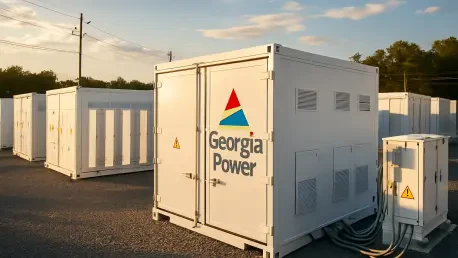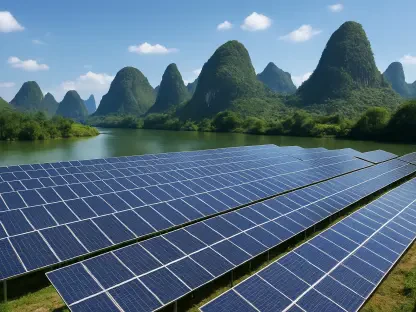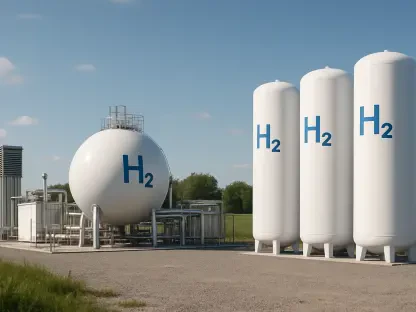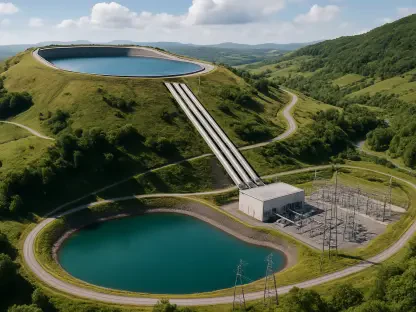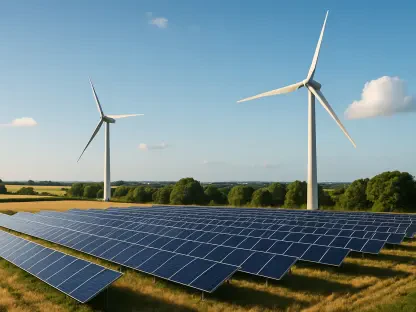Georgia Power has unveiled a transformative plan to secure 500 MW of energy storage capacity, marking a significant stride toward enhancing grid reliability and embracing sustainable energy practices across Georgia. Announced via a draft request for proposals (RFP) on September 25, this initiative is a cornerstone of the utility’s strategy to fortify the state’s energy infrastructure while aligning with the 2022 Integrated Resource Plan (IRP), as endorsed by the Georgia Public Service Commission (PSC). This move not only addresses immediate reliability concerns but also positions Georgia Power as a frontrunner in the Southeast for integrating modern energy solutions. With the flexibility to deploy standalone storage systems or pair them with renewable resources, the utility is paving the way for a resilient grid capable of meeting future demands. This ambitious endeavor reflects a broader national trend of prioritizing energy storage to balance intermittent clean energy sources and ensure power availability during critical periods.
Energy Storage as a Pillar of Grid Reliability
Building Stability for Peak Demand
Georgia Power’s commitment to acquiring a minimum of 500 MW of storage capacity, with each system offering at least a two-hour discharge duration, directly tackles the challenges of peak demand and fluctuating renewable energy output. This design ensures the grid remains stable during high-usage periods or when solar and wind generation wanes due to weather conditions. Such capacity acts as a buffer, smoothing out supply inconsistencies and preventing potential outages. By focusing on these technical specifications, the utility demonstrates a clear intent to build a more dependable energy network that can adapt to varying consumption patterns. This approach is particularly vital as Georgia experiences growing energy needs from expanding industries and urban centers, making grid stability a top priority for both economic and residential stability.
The significance of this storage capacity extends beyond immediate reliability to long-term grid planning. Scheduled for deployment between 2028 and the end of 2031, with a preference for projects operational by November 28, 2031, the timeline reflects a strategic vision that allows for thorough development and construction phases. Transparency is also a key component, as evidenced by the involvement of an independent evaluator, Ascend Analytics, and a bidders conference held shortly after the RFP release. These steps ensure a fair procurement process, fostering trust among stakeholders and potential developers. This structured rollout not only mitigates risks of delays but also aligns with the utility’s broader objectives to modernize infrastructure systematically.
Flexibility in Project Design
One of the standout features of Georgia Power’s RFP is the adaptability it offers, allowing for both standalone storage systems with grid-charging capabilities and those integrated with new or existing renewable energy sources. This versatility invites innovation from developers, who can tailor proposals to meet specific grid needs or leverage clean energy synergies. Whether focusing on pure storage to bolster reliability or combining it with solar or wind for a greener footprint, the options provided in the RFP encourage a diverse range of solutions. Such flexibility is crucial in an era of rapid technological advancement, ensuring that the utility can incorporate cutting-edge approaches as they emerge over the coming years.
Moreover, this adaptable framework supports Georgia Power’s goal of creating a balanced energy portfolio that addresses both environmental and operational priorities. By not limiting project designs to a single model, the utility can evaluate a spectrum of proposals that might offer unique benefits, such as cost efficiencies or enhanced grid integration. The RFP’s inclusive nature also signals confidence in the market’s ability to deliver viable solutions, fostering competition that could drive down costs while maintaining high standards. This strategic openness positions the utility to build a robust grid infrastructure that is both forward-thinking and responsive to the evolving energy landscape in Georgia and beyond.
Renewable Integration and Sustainability Goals
Complementing Solar Expansion
Georgia Power’s storage initiative dovetails seamlessly with its broader push for renewable energy, as highlighted by the PSC’s approval of five utility-scale solar projects totaling 1,068 MW earlier in September. These projects, developed through third-party power purchase agreements, amplify the state’s clean energy capacity and pair effectively with the planned storage systems to create a more sustainable grid. By storing excess solar energy generated during peak sunlight hours, the utility can dispatch power during periods of high demand or low generation, reducing reliance on traditional fossil fuel sources. This synergy between storage and solar underscores a comprehensive strategy to meet Georgia’s growing energy needs while addressing environmental concerns.
The integration of over 1,000 MW of solar capacity also reflects Georgia Power’s response to escalating energy demands driven by sectors such as data centers and industrial growth. Combining this renewable expansion with significant storage capabilities ensures that clean energy isn’t just produced but also utilized efficiently, minimizing waste and maximizing impact. This dual focus on generation and storage sets a precedent for how utilities can balance economic development with sustainability goals. As these solar projects come online, they will provide a critical foundation for the storage systems outlined in the RFP, creating a cohesive energy ecosystem that benefits both the environment and the economy in Georgia.
Aligning with National Trends
Georgia Power’s efforts mirror a nationwide movement toward decarbonization and grid modernization, positioning the utility as part of a larger industry shift. A statement from September 12 emphasized the integration of storage with renewables and smart grid technologies, highlighting a holistic approach to energy optimization. This aligns with the growing recognition across the United States that battery storage is essential for managing the intermittency of clean energy sources like solar and wind, as well as providing backup during outages. By adopting these practices, the utility contributes to a collective push for a cleaner, more resilient energy future that prioritizes both reliability and environmental stewardship.
Furthermore, this alignment with national trends showcases Georgia Power’s commitment to staying ahead of the curve in energy innovation. As utilities across the country grapple with similar challenges of balancing renewable integration with grid stability, Georgia’s proactive steps serve as a potential model for others to follow. The focus on smart grid compatibility and electric vehicle infrastructure integration also hints at future-ready planning, ensuring that the state’s energy systems can adapt to emerging technologies and consumer needs. This forward-looking stance not only enhances local grid performance but also strengthens Georgia’s role in the broader dialogue on sustainable energy solutions.
Operational Expertise and Phased Growth
Leveraging Existing Projects
Georgia Power is not venturing into energy storage blindly; it builds on a foundation of operational experience with projects like the 65-MW Mossy Branch Battery Facility in Talbot County, which began commercial operation in November 2024. This facility represents the utility’s first grid-connected battery energy storage system (BESS), offering valuable insights into managing and scaling such technologies. Additionally, an approved 765 MW of storage capacity is set to come online by 2026, further expanding the utility’s portfolio. This phased approach allows for incremental learning, enabling Georgia Power to address technical challenges and refine operational strategies before the larger wave of projects from the current RFP takes shape.
The gradual buildup of storage capacity through existing and near-term projects also provides a testing ground for integrating these systems with Georgia’s energy grid. Lessons learned from Mossy Branch and the upcoming 765 MW of storage will inform best practices for deployment, maintenance, and grid interaction, reducing risks associated with the ambitious 500 MW target. This methodical scaling ensures that each new project benefits from prior experience, enhancing overall efficiency and reliability. By prioritizing a step-by-step expansion, Georgia Power demonstrates a pragmatic commitment to mastering storage technology as a core component of its energy strategy.
Ensuring Seamless Integration
Technical stipulations in the RFP underscore Georgia Power’s focus on seamless integration of new storage systems with existing infrastructure, particularly through interconnection requirements with the Southern Company transmission system. For projects pairing storage with renewables, a shared interconnection point is mandated, promoting operational efficiency and minimizing potential disruptions. Additionally, the exclusion of company-owned land for third-party projects unless proposed by Georgia Power itself ensures tight control over grid compatibility, reducing the likelihood of integration issues that could compromise performance or reliability across the network.
This emphasis on technical precision extends to the broader goal of maintaining a cohesive regional energy framework. By setting clear guidelines for how new facilities connect to the grid, Georgia Power mitigates risks of inefficiencies or conflicts that often arise in large-scale energy deployments. The structured procurement process, with proposals due in January 2026 and contracts anticipated by early 2027, further supports this integration by allowing ample time for regulatory review and planning. Such meticulous attention to logistical and operational details reinforces the utility’s dedication to building a grid that is not only more reliable but also adaptable to future technological and energy demands.
Reflecting on Strategic Milestones
Georgia Power’s pursuit of 500 MW of energy storage capacity, potentially paired with renewable resources, stands as a defining moment in its mission to enhance grid reliability and sustainability. The initiative, guided by the 2022 IRP, showcases a balanced approach that integrates cutting-edge storage solutions with a growing renewable energy portfolio. Collaboration with the PSC and the use of an independent evaluator ensures transparency and fairness throughout the process, setting a high standard for utility-scale projects. Looking back, this effort marks a significant step forward in addressing Georgia’s energy challenges. Moving ahead, stakeholders are encouraged to closely track the RFP outcomes, assess the impact of deployed projects, and explore how these advancements could inform future policies and innovations in the state’s energy sector.
